|
 Gloiocephala nothofagi Gloiocephala nothofagi
BiostatusPresent in region - Indigenous. Endemic
Images (click to enlarge)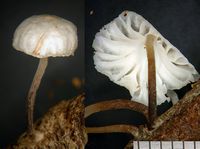
Owner: J.A. Cooper | 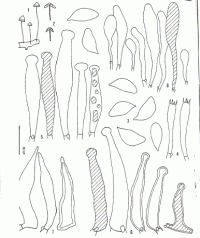
Caption: Fig. 2 (1-8). Gloiocephala nothofagi Desjardin & E. Horak (PDD, holotype).- l. Basidiomes.-
2. Basidiomes (x2).- 3. Basidiospores.- 4. Basidia.- 5. Cheilogloeocystidia.-6.Caulogloeocystidia.- 7. Caulosetae.- 8. Pileipellis. | 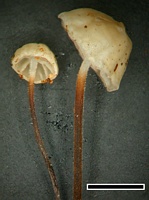
Caption: scale=5mm
Owner: J.A. Cooper | 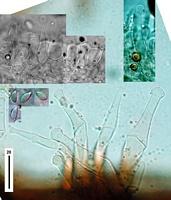
Caption: upper left: pilocystidia. Right: cheilocystidia. Lower caulocystidia.
Owner: J.A. Cooper | 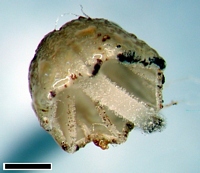
Caption: scale = 0.5mm
Owner: J.A. Cooper | 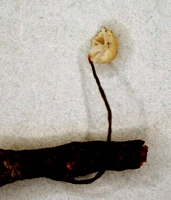
Owner: J.A. Cooper | 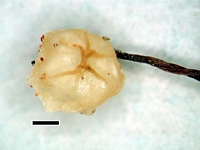
Caption: scale = 0.5mm
Owner: J.A. Cooper | 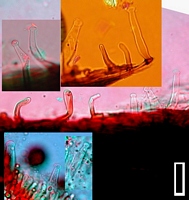
Caption: scale = 20um. Inset lower left cheilocystidia. Remainder caulocystidia.
Owner: J.A. Cooper | 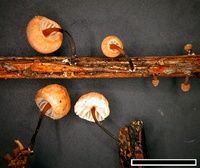
Caption: scale=5mm
Owner: J.A. Cooper | 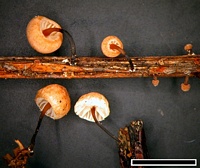
Caption: FUNNZ2007/1316
Owner: FUNNZ | 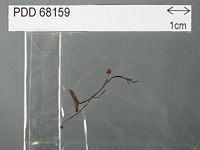
Caption: Dried type specimen
Owner: Herb PDD |
Article: Desjardin, D.E.; Horak, E. (1997). Marasmius and Gloiocephala in the South Pacific Region: Papua New Guinea, New Caledonia, and New Zealand taxa. Bibliotheca Mycologica 168: 152 p.
Description: Pi1eus 3-5 mm diam, hemispherical to convex with a central, low, obtuse papilla (often only wart-like), weakly plicate; surface dull, dry, minutely pruinose; off white to pale grey, turning pale
reddish brown with KOH; dried pilei appearing like plastic. Texture membranaceous; context very
thin, white.-Lamellae adnexed, distant (7-9) with no lamellulae or with a few scattered lamellulae,
subventricose, off-white; edges fimbriate, concolorous.- Stipe 12-28 x 0.3-0.5 mm, central, equal,
cylindrical, wiry, tough, conspicuously pruinose overall, insititious; apex white, black elsewhere.
Odor and taste not distinctive.
Basidiospores 8-11 x 4-5 µm, broadly subfusoid, smooth, thin-walled, hyaline, inamyloid.- Basidia
30-36 x 6-7 µm, subclavate to subcylindrical, 4-spored, clamped.- Cheilogloeocystidia abundant,
45-70 x 6-11 µm, tibiiform, capitulum 7-10 µm diam., thin-walled, hyaline, with reddish brown
plasmatic pigment in KOH.- Pleurogloeocystidia absent. - Pileipellis a hymeniform layer of
subcylindrical to clavate cells, 20-60 x 4-12 µm, thin-walled, hyaline, with orange resinous
contents; capitate pileo-gloeocystidia absent.- Tissues inamyloid, non-gelatinous.- Caulocystidia of
2 types: a) caulogloeocystidia 30-70 x 8-10 µm, tibiiform to fusoid-capitate, thin-walled to thick-walled, capitulum 5-7 µm diam.; walls hyaline, with brown plasmatic pigment; b) scattered
caulosetae, 50-60 x 8-10 µm, fusoid to lanceolate, acute, thick-walled (up to 1 µm diam); walls
hyaline at stipe apex, brown elsewhere.- Clamp connections present.
Habitat: Habit, habitat and distribution.- Solitary, on rotting twigs of Nothofagus fusca (Fagaceae), not on
leaves. New Zealand.
Notes: Gloiocephala nothofagi displays a number of unusual features, including a pileipellis composed of
subcylindrical gloeocystidioid cells of varying lengths but lacking projecting capitate gloeocystidia,
and caulocystidia of two types, viz. capitate gloeocystidia like those in the hymenium, plus setae.
This combination of characters is unique in Gloiocephala. The pigmented pileus would suggest
placement in sect. Gloiocephala, subsect. Religiosae.
Macroscopically, G. nothofagi is reminescent of G. caucasica (Sing.) Singer, but the latter species
differs in forming thick-walled, broadly clavate to sphaeropedunculate pileipellis cells, and
ventricose-mucronate hymenial cystidia (fide Singer, 1937).
|